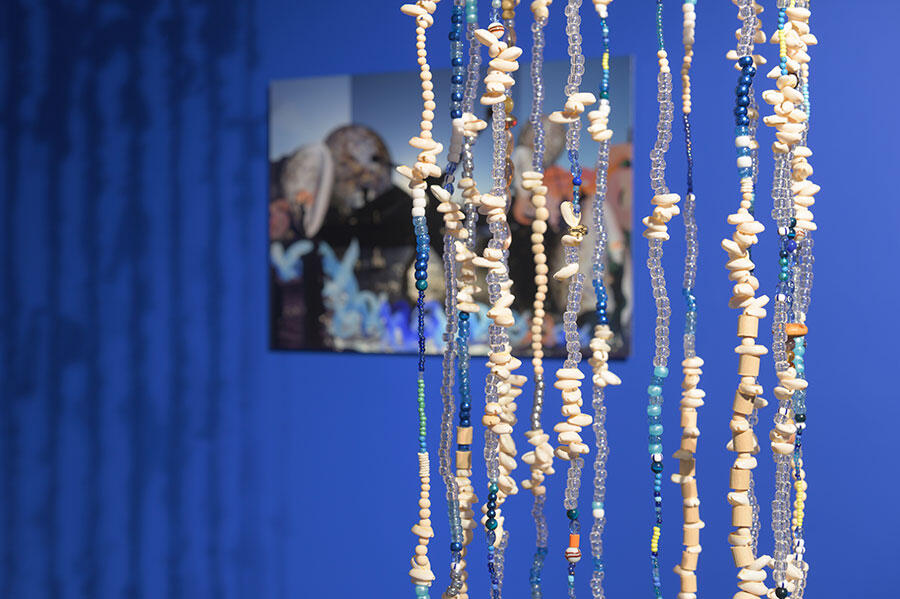'Sex Ecologies' Imagines Life in the Debris of Imperialism
At Kunsthall Trondheim, Norway, artists plant sites of refuge in an earth scarred by colonialism
At Kunsthall Trondheim, Norway, artists plant sites of refuge in an earth scarred by colonialism

Backdropped by the coastal squall beyond the gallery’s tall vitrine windows, the nine works commissioned for ‘Sex Ecologies’ are installed around Kunsthall Trondheim like lushly planted beds in a co-operative greenhouse. Several centre botanical textiles, such as the silk curtains embroidered with river grass that seclude Margrethe Pettersen’s Láibmat (Drifting, all works 2021), an audio trail of the artist floating on the nearby Nidelva River and singing to the current in Sámi, or the violet, bazin riche pouffes of Supernova Fruit, I’m so glad you chose me, Anna Tje’s hymn to safou fruits and the Cameroonian women who sell them in Paris. Others gush entire colour spectra, including Mother of Pearl 方, a quartet of pennanted satin prints by Jes Fan, which iridesce with the nacre interiors of oysters native to Hong Kong’s bays, while in The Worm: Terrestrial, Fantastic and Wet Anne Duk Hee Jordan uses Day-Glo polymer tubing to blow up flagellating, black-lit bacteria to the scale of a human rave.

Each houses a mélange of erotics, care and play that obliquely indicts imperialism’s central logic of monoculture. More directly, these works also enjoin questions with present-day and particular implications: who gets to live by which bodies of water? Whose foods are regarded as exotic? When does a stamp of possession fade? How is life valued that ordinarily remains unperceived?

This critique-by-contrast is fullest in two works that engage the symbols of the Atlantic. In Repose without rest without end – a cove-shaped, four-channel video installation, choreographed by Okwui Okpokwasili and frequent collaborator Peter Born – dark, roiling water is projected across two vertical screens, hung several meters apart and slightly askew, as well as the ground in between. A sun of apricot plastic hangs with its edge grazing the sea surface that covers the floor, while the waves on each of the facing screens are superimposed with round-framed, short-clipped footage that peers into the commonplaces of dozens of Black subjects. As their faces appear in the ocean, they return the camera’s gaze, making eyes as they play bugles and shimmy waists, chew gum and braid hair, mug and scowl as they wait for a moped ride or the lens to cut away.

Meanwhile, Alberta Whittle’s installation throbs with mordant humour and tender admiration for the array of undersea lifeforms that have capsized the icons of settler enterprise. A pair of small digital collages, Smoking Mirrors and Dreaming Other-ways, layer together giant cowrie shells and corals bloomed from the shrunk-down, sunken hulls of Christopher Columbus’s carrack ships with nine pictures of the artist in silhouetted profile and frontal photo-negative as she flourishes long-stemmed squashes carved into drinking gourds – the code name used for the Big Dipper constellation on the Underground Railroad, which enslaved people followed northward to freedom. Power from Below, a woodblock matrix that Whittle has introduced to seaworms, appropriates a Theodor de Bry copperplate depicting the theft of the slave-trader Francis Drake’s hat by the indigenes of Río de la Plata; the adjoining print is blank where the worms have eaten away the wood and decayed an archival record of the ‘Age of Exploration’.

As an ecosystem, ‘Sex Ecologies’ furnishes a protective and symbiotic habitat in which its participants can probe the source of much of the ideological and material blight wrought by Euro-American colonialism, from hegemonies of species, gender and race to climate collapse. Alongside this diagnostic function, the show also holds space for the artists to propose how to plant sites of refuge in the scars torn into the earth by mass theft – not to redeem an Eden that was lost, but to lean together, year-upon-year, in the joyous toil of growing something new.
‘Sex Ecologies’ is on view at Kunsthall Trondheim, Norway, until 6 March 2022.
Main image: Margrethe Pettersen, Láibmat (detail), 2021, sound installation and silk room, 280 x 380 cm. Courtesy the artist. Photograph: Daniel Vincent Hansen.























